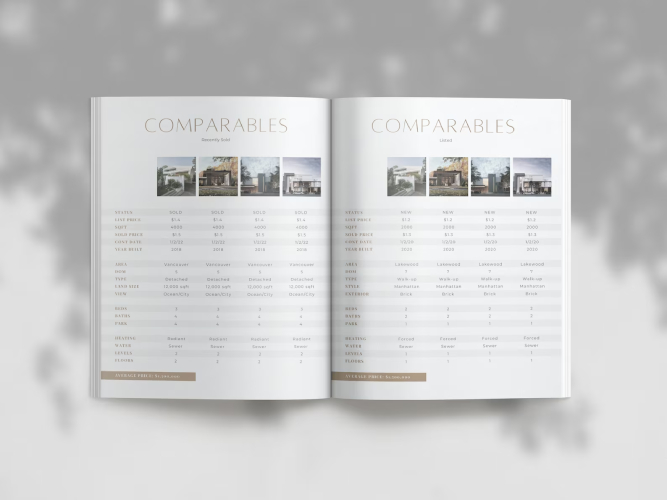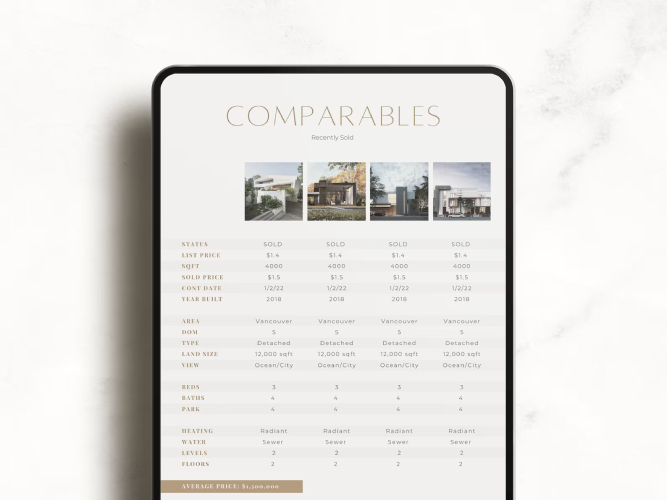An essential part of a real estate agent’s responsibilities includes being able to clearly communicate a pricing strategy for any property and identify current market trends. Comparative market analysis (CMA) reports help real estate agents evaluate and determine the market value of a property. A successful agent is able to create an accurate CMA report that explains these market trends and helps their clients make informed decisions.
As an agent, I have prepared many reports analyzing pricing trends to help provide guidance to buyers, sellers and investors alike. I’ll share more information on exactly what a CMA is, why it’s important and the steps to creating a CMA report that’ll impress your clients.
What is a comparative market analysis (CMA)?

A comparative market analysis, or more widely known as a CMA, is a pricing tool real estate agents use to estimate the market value of a property. To create this report, you start by gathering information on one home, known as the subject property. It is then measured against similar properties – often called comparable properties or “comps” – that have recently sold or that are currently listed to determine the subject property’s estimated worth.
How a CMA is used and why it’s important
A comparative market analysis not only assists real estate agents in communicating current market trends to their clients but also provides valuable insights into pricing strategies for both buyers and sellers. A CMA is more than just numbers, it’s a tool for you to educate your clients and help them make informed decisions, whether they are listing their current home for sale or looking to purchase a new one. These reports are important pieces of the puzzle for every member of a transaction.
- For buyers: Help determine if the property they’re interested in is priced correctly and if it is a sound purchase.
- For sellers: Decide the best price at which to list their property and ensure they get the best return on it. Sellers would be able to carefully review comparable properties on the market as well as those that have successfully closed. CMAs are helpful during listing appointments when you speak to clients about pricing their property.
- For agents: Showcase your expertise by giving yourself a powerful and insightful way of explaining your recommendations with reasoning to back you up.
What’s included in a comparative market analysis
To get your comparative market analysis just right, there are specific things that need to be included in your report.
- Subject property: Start by including details about the property that you are evaluating. Be sure to include pertinent details like square footage, year built, number of beds and baths, and notate any recent upgrades.
- Recently sold comps: Use comparable sold properties that have sold in the last 30-90 days and under a five-mile radius from the subject property. Using comparable properties that are closest to the subject property and sold more recently will reflect the most accurate market data.
- Active and pending listings for context: Markets can shift quickly, so use this data to determine if homes are sitting on the market longer or priced higher or lower than ones that have recently sold.
- Adjustments for differences in features, condition and location: Finding exact comps can be hard sometimes, which will result in making monetary adjustments to the price estimation. For example, if the subject property has an updated kitchen and the comp doesn’t, positively adjust your price to reflect the kitchen updates.
- Local market trends: The report should showcase how the market is behaving. Be sure to show how long homes are sitting on the market and any fluctuations in pricing.
- Pricing strategies: The overall goal of a CMA is to estimate how much a home may be worth. Whether you’re getting ready to list a property or have a buyer making an offer on a new home, use your expertise to convey a pricing strategy as a part of your report.
What not to include in a CMA
While it’s important to know what goes into a CMA, I believe it’s just as important to highlight a few things that should not be included.
- Personal owner information: Do NOT include names or details of any owners in the comps.
- Property appraisal information: Unless you’e a licensed appraiser, stay away from including information on previous appraisals.
- Detailed description of each property: CMA reports are meant to be simple and effective tools. Just include the basics of each property; irrelevant information will only confuse your clients.
- Unlike properties: Omit any properties in completely different locations, those in a different size, location or price range.
How to create a CMA: A step-by-step process
Creating a strong CMA doesn’t have to be difficult. Be sure to use recent and reliable data, good judgement and include your local knowledge. A comprehensive CMA report should be broken out into five sections. Let’s take a look at the steps you should take to develop your report.
Step 1: Gather details on the subject property
Whether you’re evaluating a listing for a seller client or a potential property purchase for a buyer, you’ll want to include details about the subject property. This includes the number of bedrooms and bathrooms, home size, lot size, amenities (e.g. pool), age of the property, any renovations or upgrades, the condition of the property, its construction or design style as well as its physical address and location.
Step 2: Find comparable properties
There are two types of comparable properties you can include in your CMA report: recently sold and active/pending listings. The strongest pricing indicator will be properties that have recently sold and are within close proximity to the subject property. Active and pending listings will give you insights into whether the pricing trends are remaining the same or shifting.
Recently sold properties
In a hot market, you’ll ideally want to look for three to five comps that have sold in the last 90 days within a one to three-mile radius. In general, I recommend trying to find properties that have sold within the last three months and are no more than five miles from the subject property. However, if you service a less populated area or the market is a bit slower, you may need to go a little farther out from the subject property or go back more than three months.
You’ll want to include properties with the same characteristics as the subject property. These include:
- Square footage
- Number of bedrooms
- Number of bathrooms
- Lot size
- The year built
- Condition
- Upgrades and renovations
- Style of home (i.e. construction type, building materials, number of floors)
Pro Tip
If you have to go out longer than 6 months or over five miles from the subject property, ask your principal broker for advice. In some situations, you may want to advise your client to order an appraisal if an accurate CMA cannot be completed.
Active or pending listings
You will also want to include two to three active or pending listings near to the subject property. The distance will really depend on your market and your knowledge of the surrounding neighborhoods. Again, be sure to choose homes similar to the subject property. If there are multiple active or pending listings to choose from, you’ll want to limit your chosen comps to those that hit the market most recently.
These listings will not weigh as heavily in your pricing decision unless it proves that the market is shifting. Here are a few examples:
- Hot market example: Recently sold listings show a home’s estimated value to be $425,000. However, active and pending listings show comparable properties listed around $475,000, and the days on market are very low. This may be an indication that the market is adjusting quickly, and the home’s value could actually be higher than anticipated.
- Declining market example: Recently sold listings show a home’s estimated value to be $425,000. However, active and pending listings show comparable properties listed around $375,000, and the days on market are averaging more than 30 days. This may be an indication that the market is declining and the home’s value could actually be lower than anticipated.
Pro Tip
Using active and pending listings is where your expertise comes into play. As the professional, you know the current market conditions, and it’s your job to help your clients understand how these factors may play into the value of their current home or how to make an offer on one.
Step 3: Adjust for differences
Now that you’ve gathered all the necessary data, it’s time to examine the properties a bit closer. You will rarely find a home that is the exact duplicate of your subject property, so it will be important to make adjustments based on the key differences in each property. You’ll want to adjust for differences in square footage, upgraded property features, or additional bedrooms or bathrooms – just to name a few.
Example: Your subject property does not feature any upgrades, but a comparable home has a newly renovated kitchen. You may subtract $10,000 to reflect that difference. In reverse, if your subject property had the renovated kitchen, you’d add $10,000 to the price. Remember, you only make adjustments to the subject property. Use your knowledge of the local market to help estimate these value adjustments.
Step 4: Review current market conditions
Here’s where your hyper-local market knowledge can really shine! It’s important to consider the market at the hyper-local level to evaluate neighborhood trends when creating a CMA report. In more populated cities, many different neighborhoods are very close together, but property values can vary significantly from one to the next. For example, in New York City, the West Village and Greenwich Village are next to each other, but there are major price differences in housing in each of these neighborhoods.
It is essential to use your knowledge of where properties are located when including them in your comparative market analysis. Small details can show your client that you are highly knowledgeable and that they can trust your judgement.
Step 5: Combine your findings into one report
Here’s where you’ll bring your research and expertise together to create one cohesive report. It should be easy for your client to read and understand. Your goal should be to strike a balance between reporting data and telling a story. It should tell your clients why you’re recommending a particular price and include evidence to back it up.
A polished CMA report should include:
- Cover page: Include your name, brokerage and branding along with the clients’ name, subject property address and date of the report.
- Subject property overview: Include key details about the subject property, including square footage, lot size, number of bedrooms and bathrooms, the year built and any unique features.
- Map showcasing comps: Include a visual representation of the proximity of the comps from the subject property.
- Side-by-side comparison table: Showcase your subject property first, with each sold comp next to it. Use an additional page to list additional sold comps or active and pending listings.
- Market trends summary: Write a brief overview of the local market, including stats like the average days on market and price per square foot.
- Suggested pricing strategy: This is where your agent voice matters. Provide your recommendation and explain it to your client in plain language while making sure the bottom line recommendation stands out. (i.e. bold the actual pricing recommendation or unique features)
Pro Tip
Don’t forget to take into consideration the needs of your client. If you have a seller who needs to move quickly, make sure you convey the “why” in your pricing strategy.
Step 6: Present a client-friendly CMA report
Now that your CMA report is complete, don’t just send it off via email. Make an appointment with your client to sit down and go over it together. I recommend having a PDF version and a printed version, so you can leave a paper copy with your clients, but also send the electronic copy for their records – and yours.
Here are a few tips on how to make your CMA report easy to read and understand:
- Use visuals
- Add commentary
- Keep it simple
- Include a pricing summary page
Where to find good CMA report templates online
There are several templates available online that help you create an effective and accurate CMA report. You can find free templates or purchase more advanced ones to provide your clients with a more detailed report. Your brokerage or MLS may also have a branded template available for use. You may also want to find a few and take the best formatting of each to create your own using tools like Canva.
CMA Reports: FAQs
What’s the difference between a comparative market analysis and an appraisal?
A comparative market analysis is an evaluation of a property’s value based on comparable properties in the area. It allows agents and their clients to compare similar properties relevant to their analysis.
An appraisal is a more detailed professional report that provides a property’s appraised value based on a thorough inspection and analysis of the property’s condition and features. It is used by lenders and third parties to ascertain a specific price point of a home.
How many comps should be included in a comparative market analysis?
There is no set number of comps that should be included in a CMA report. The number of comps you include will depend on the availability of comparable properties in the area and the quality of the data. I like to focus on having three to five ACTIVE listings and three to five recently closed properties, for a total of five to eight properties, for a complete picture.
What data sources should I use in a comparative market analysis?
When creating a CMA report, it is essential to use reliable data sources. These may include local real estate listings, county property records and MLS databases. The information should be recent and relevant to the current market. If there are no data points, older items may be included but there should be a footnote disclosing this.
The full picture: CMA Reports
As agents, we have to filter through a lot of data to build a pricing strategy for our clients. Doing this difficult task is our job, not the clients. If you take away anything from this article, it should be that a CMA report should be accurate, include your expert insights and be easy for the client to digest.
A strong CMA doesn’t just report on sales data or list the features of a home, it builds trust and positions you as the expert they need to hire to reach their homeownership goals. When an agent combines their presence in the market with a solid CMA report, it makes your client feel confident in your pricing strategy. Whether you’re helping a buyer make a competitive offer in a hot market or pricing a home to sell for top dollar, a strong CMA can be the one piece of your presentation that will sell your client on you and your brand.


















